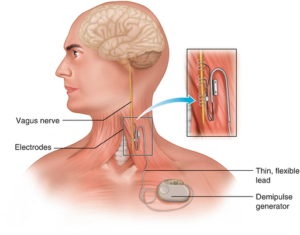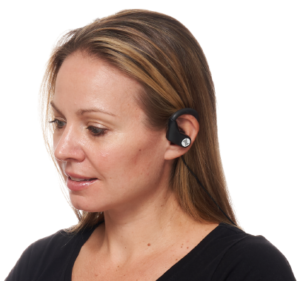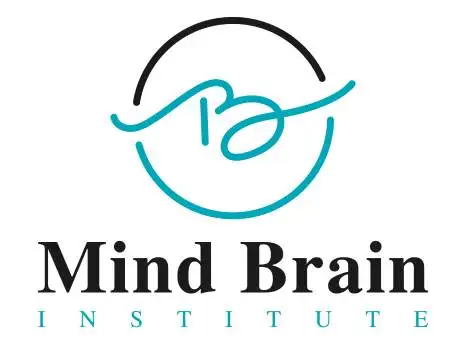
- Posted By Dr. Anuranjan Bist
- Comments 0
Table of Contents
Introduction: The Rise of Bioelectronic Medicine
If your body had a secret button, you could press it, which would relax you, lessen pain, and bring on happiness, all without help from pills or surgery. Sounds futuristic? Bioelectronic Medicine, or the use of gentle electrical impulses to deal with chronic diseases, is what we are discussing today.

An interesting new approach claims to increase health by touching the vagus nerve through the skin, this is called Transcutaneous Vagus Nerve Stimulation (tVNS). It may seem technically difficult, but it is a quite simple method, and uses a compact device placed on the neck or ear. The simplicity of this method makes it a preferred choice for managing issues like migraines and anxiety.
Let’s explore what tVNS is, and how it subtly makes a difference.
What is Transcutaneous Vagus Nerve Stimulation (tVNS)?
Transcutaneous Vagus Nerve Stimulation is a non-invasive, drug-free technique for stimulating the vagus nerve. The vagus nerve is a key nerve in the nervous system that regulates your heart, digestion, and mood.
In contrast to conventional vagus nerve stimulation, Transcutaneous Vagus Nerve Stimulation is administered using an adhesive electrode placed on the skin (that is why the name ‘transcutaneous’). You just attach a tiny probe to the ear or neck, and it uses gentle electrical pulses to activate the nerve.
So, what is so exciting? Engaging the vagus nerve can soothe your body, lower your stress, and control inflammation. At this moment, it’s being used and evaluated for conditions such as depression, epilepsy, anxiety, migraines, and digestive disorders.
You could call it a mild reminder to your body’s center that helps you stay balanced and in control without using drugs or surgery.
How Does the Vagus Nerve Stimulation Work?
In order to understand how vagus nerve stimulation works, it is necessary to understand what the vagus nerve is. It is the longest nerve in your body, and is a part of your parasympathetic nervous system that is responsible for your “rest and digest” functions.
If your vagus nerve is stimulated, it prompts your brain to decrease your heart rate, bring down inflammation, and improve your outlook and attention. This is even more useful when your symptoms come from anxiety or PTSD because these can lock your nervous system in fight-or-flight mode.

(Source: Yap et al., 2020)
Simply, technology does not require surgery to achieve stimulation. Almost all devices are applied around the ear or on the neck, directly touching the skin where branches of the vagus nerve are found.
The electrical pulses sent when the device is activated activate the nerve. As a result, the brain changes neurotransmitters and shuts down overactive functions. Essentially, Transcutaneous Vagus Nerve Stimulation calmly hugs your body and sends the message that things are going to be all right.
Explanation of Non-Invasive Vagal Modulation
Transcutaneous Vagus Nerve Stimulation stands out because it’s a non-invasive approach. It means you’ll skip surgery, stay away from implants, and avoid any downtime. With just a small gadget and a short routine, you’re on your way to better fitness.
Vagal modulation of this kind is like servicing your nervous system, yet you don’t need to open anything under the hood. Using it from home through the skin is easy, so consumers only need a phone app or wearable gadget.
Yet, the straightforward approach shouldn’t mislead you. Transcutaneous Vagus Nerve Stimulation (tVNS) is being studied for various severe medical issues. Researchers and doctors note that it might assist with:
- Depression and Anxiety
- Epilepsy and Migraine
- Chronic pain and fibromyalgia
- Inflammatory issues like IBS and arthritis
Another reason that makes it exciting is that it’s personalized. In this process, the devices can be adjusted to calibrate intensity and duration to suit your comfort level. Transcutaneous Vagus Nerve Stimulation offers a promising path for anyone who wants to manage stress, mood, or pain naturally.
Types of Devices for tVNS
There are different types of devices used for Transcutaneous Vagus Nerve Stimulation. Each of these tVNS devices offers different results in terms of effectiveness. Although all of these therapies focus on the vagus nerve, the ways and areas they are applied may change.
Auricular tVNS
Articular tVNS focuses on the ear, with points like the tragus or cymba conchae being important, since these areas have adult branches of the vagus nerve nearby. It seems like you’d plug little clips or electrodes into your ear for the procedure.

Several of them appear to be just like Bluetooth headsets or earbuds. They are especially discreet and are becoming popular in discussions about mental health.
Cervical tVNS
They are often attached to the skin where the vagus nerve is located along the side of the neck. Even though they are bigger than the pocket options, they can still be carried with you. GammaCore is a device meant to ease migraine and cluster headaches, and it is often approved by doctors and can be managed through an app.

(Source: McIntire et al., 2021)
You can also get models you can put on as you would like a bandage or patch, and they run preset stimulation treatments on their own. A different group of massagers comes with an app, so you have control over the frequency, power, and how long the session will last.
Whatever type of stimulation is used, the goal is to help the vagus nerve and allow your body to balance itself. The highlight of all this is that. No need to go to a hospital, you’re in charge of your progress.
Safety Characteristics and List of Side Effects
Any therapy that uses electrical energy always makes safety a priority. Luckily, there is some good news. Transcutaneous Vagus Nerve Stimulation is very safe. Having vagus nerve stimulation done this way is much safer than a surgical alternative. You don’t have to cut or use implants, and there’s no downtime afterward. Treatment with tVNS devices tends to proceed smoothly for people at home.
Even so, there are still a few side effects associated with the treatment. Several users say:
- A little inflammation or redness can appear at the contact points of the electrodes
- A feeling of pulsing or tingling as you use your teeth.
- Occasional feeling of lightheadedness or dizziness, especially at the beginning.
Usually, such effects are minor and disappear quickly. You should start at a light setting and move up when your body gets used to the workout. Besides, you should always see a doctor if you have a heart rhythm disorder or epilepsy, or if you use a pacemaker, before trying Transcutaneous Vagus Nerve Stimulation.
For most individuals, tVNS is a very safe method. The way it works is gentle and ideal for helping anyone who wants a way to support their nervous system with little or no risk.
Conclusion – A Promising Future for Non-Invasive Vagus Nerve Therapy
While many treatments and fast solutions are popular, transcutaneous vagus nerve stimulation offers a science-backed and gentle alternative. It not only covers symptoms but also helps correct imbalances where they are the worst.
Wearable technology is becoming smarter, and the research is getting stronger could make Transcutaneous Vagus Nerve Stimulation a regular household technological tool as popular as meditation or yoga. If you want to relax, concentrate better, or aid in your recovery, tVNS is a simple and effective solution.
The human body can heal itself. However, sometimes, it needs a little extra help to start healing. Contact Mind Brain Institute for the best tVNS therapy available.


